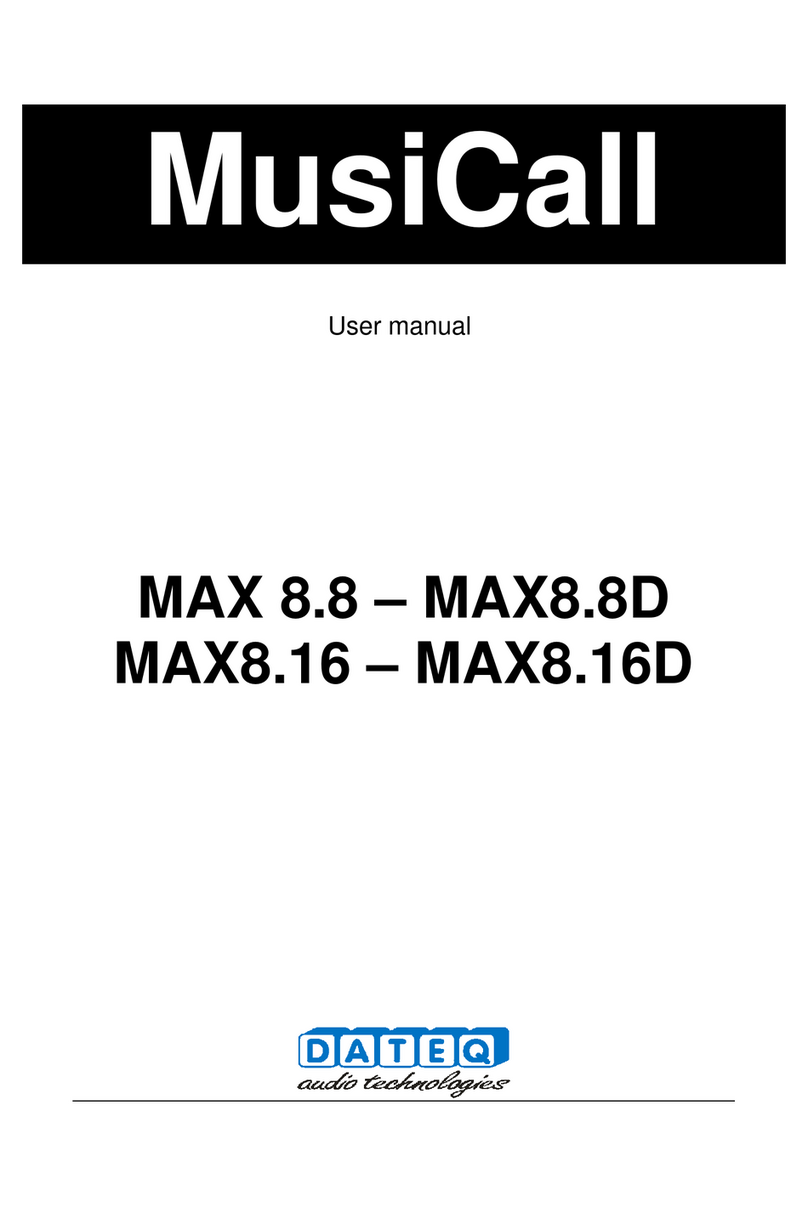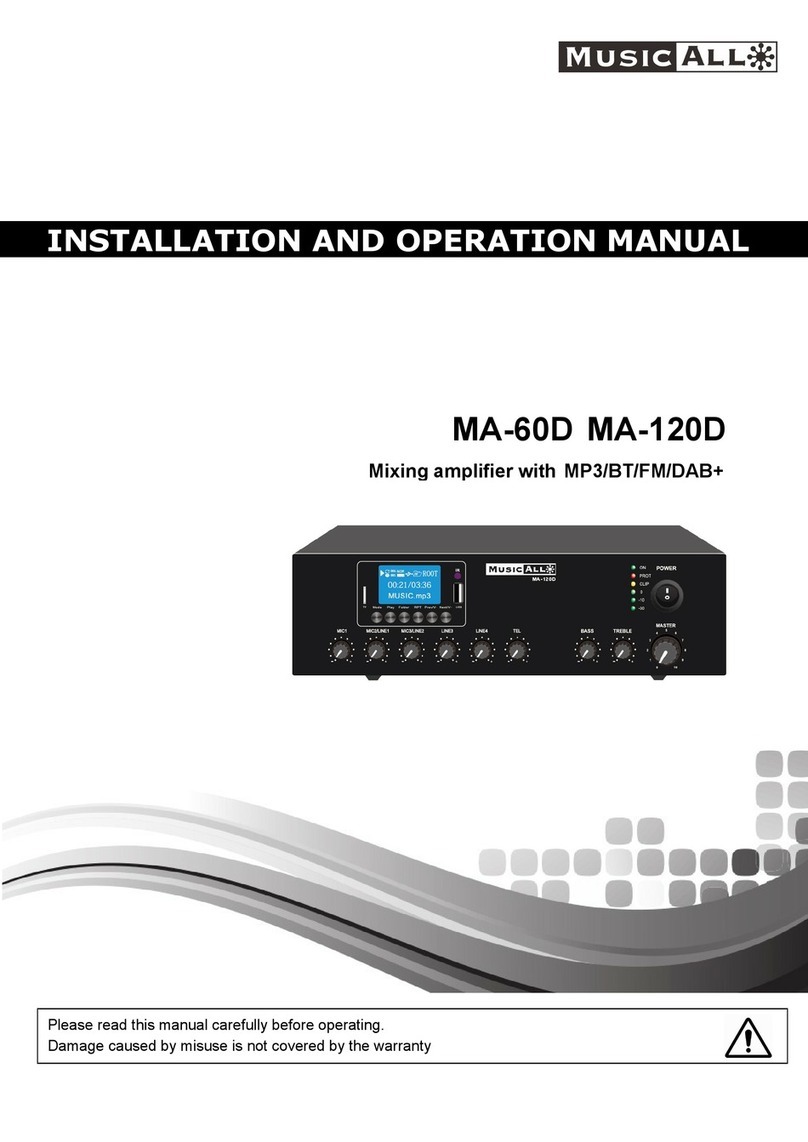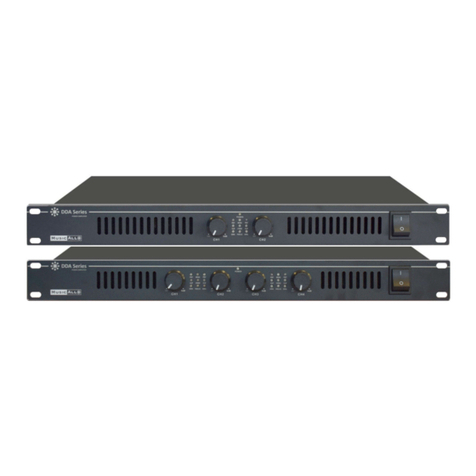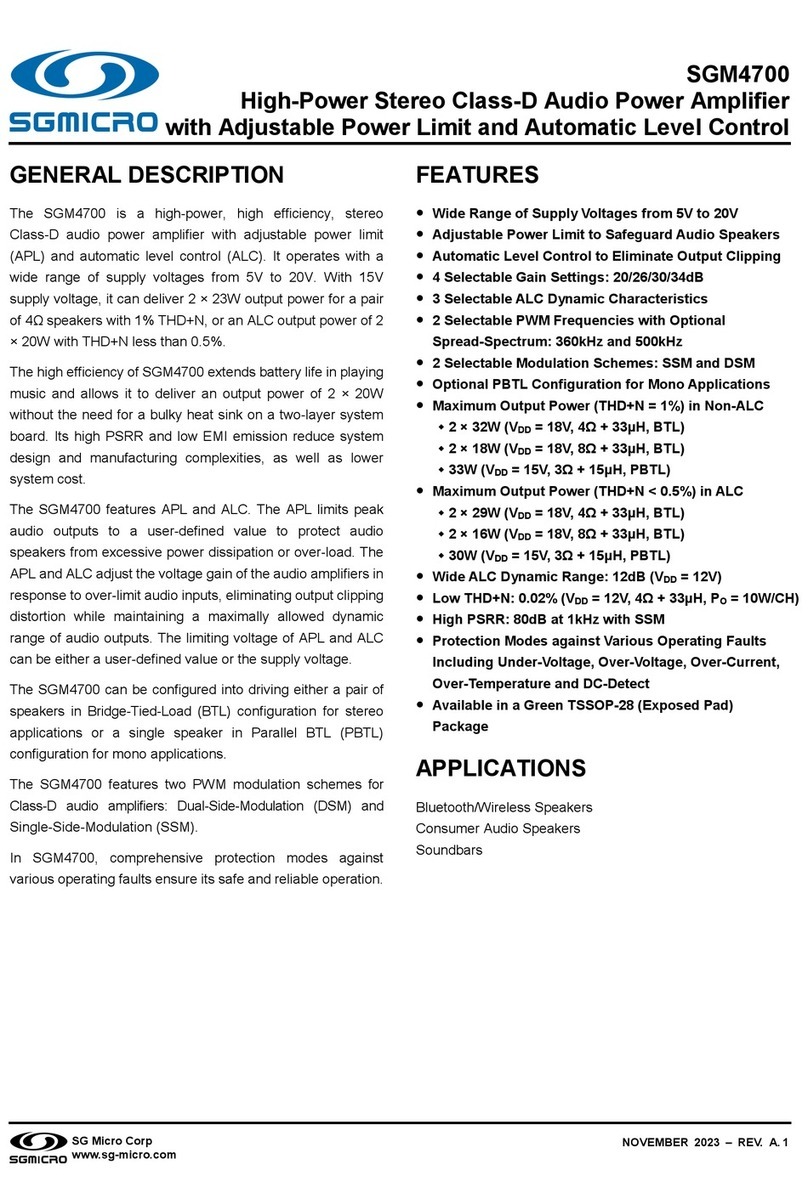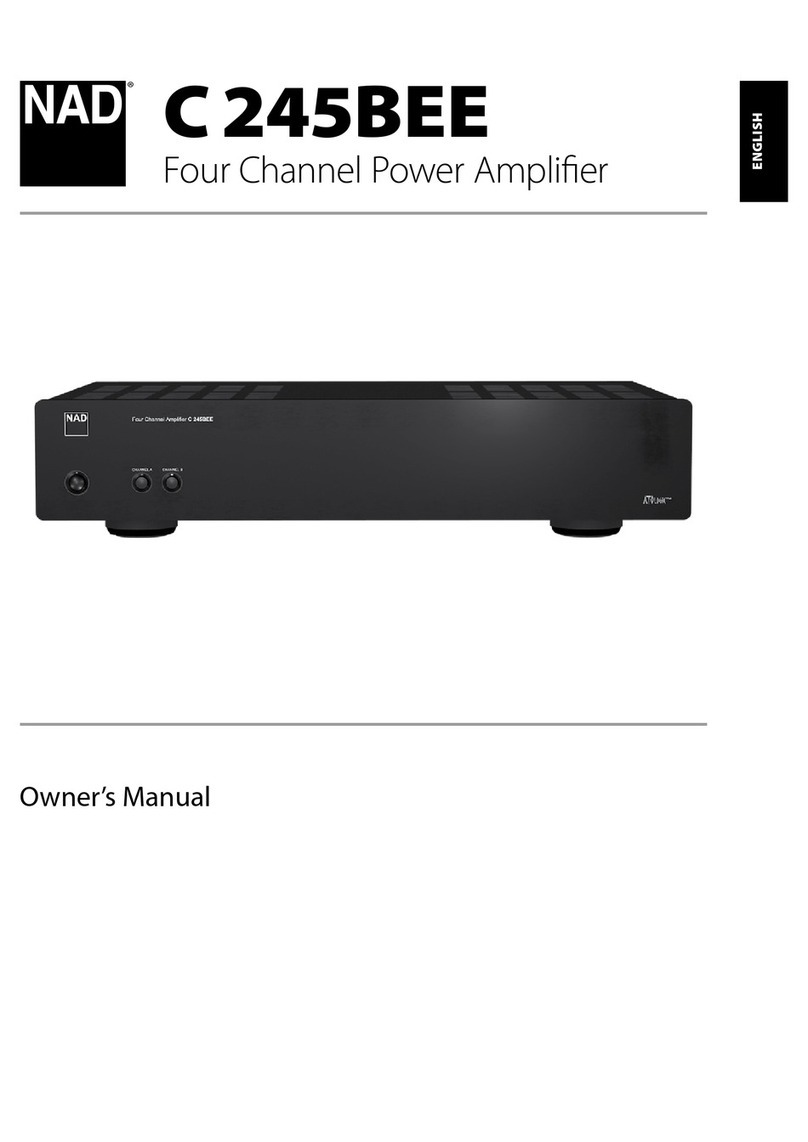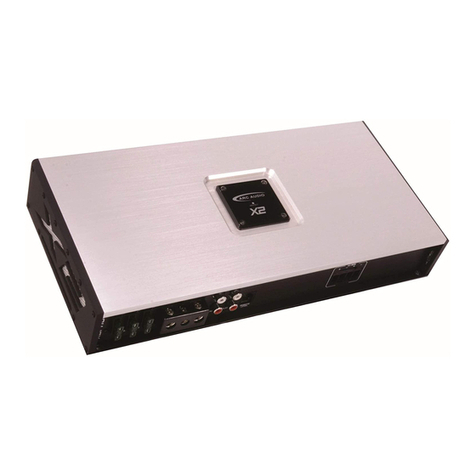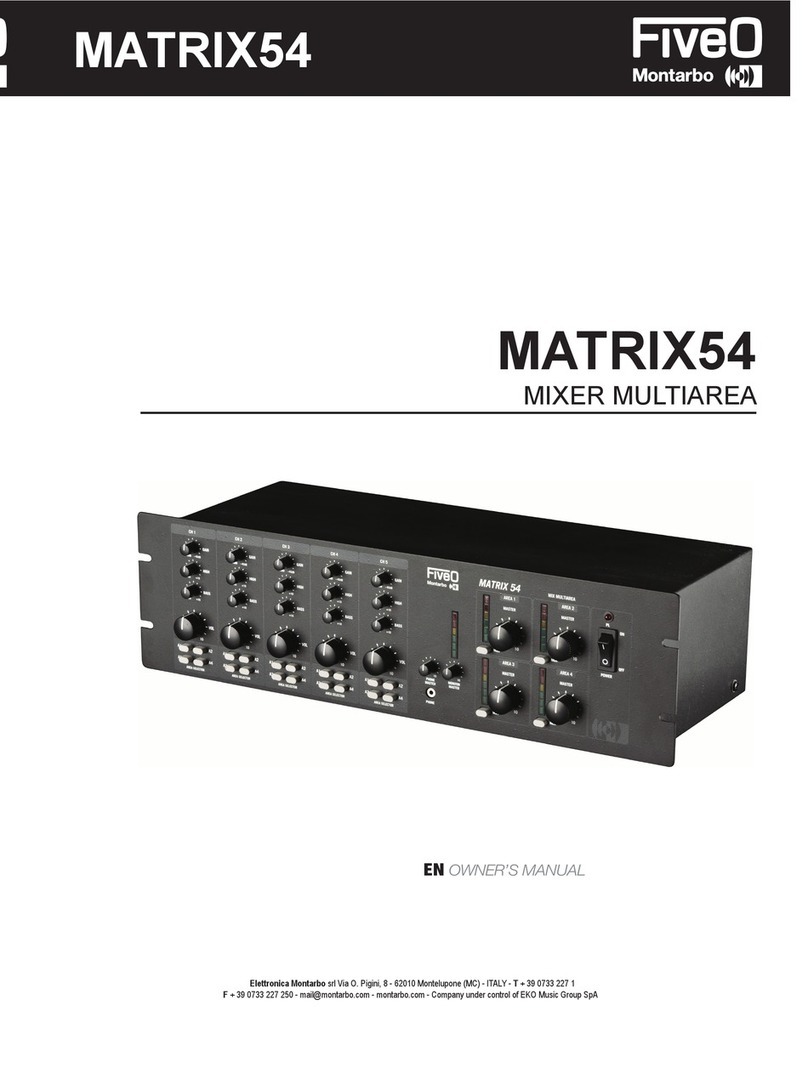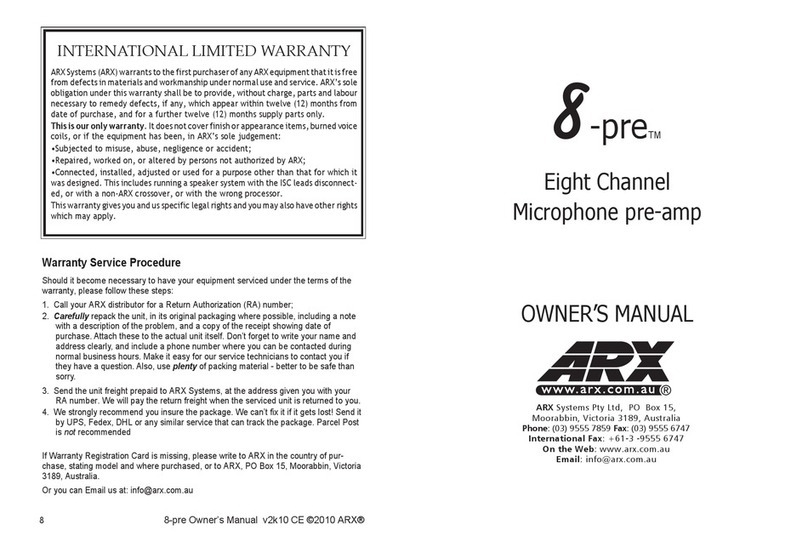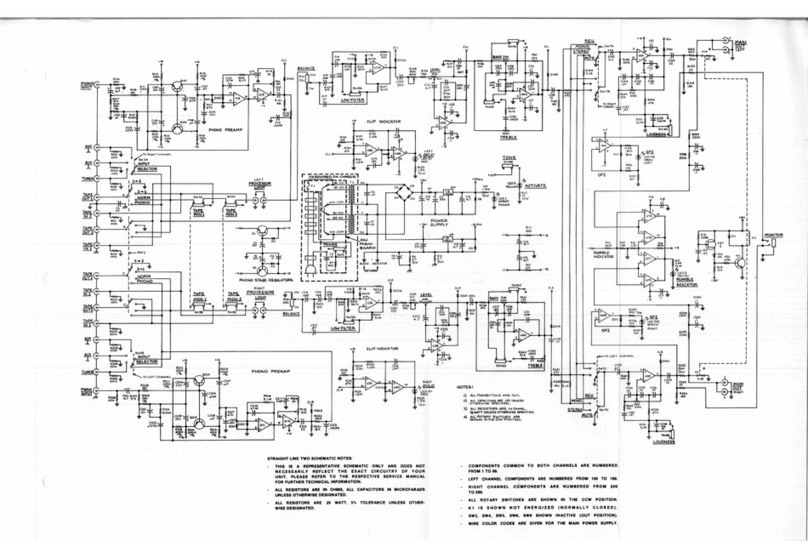Dateq Dymand User manual

DYMAND
GEBRUIKSAANWIJZING
USER MANUAL
GEBRAUCHSANWEISUNG
MODE D’EMPLOI


1Dateq DNA-Dymand Manual Safety instructions EN
Safety instructions
1All safety instructions, warnings and operating instructions must be read first.
2All warnings on the equipment must be heeded.
3The operating instructions must be followed.
4Keep the operating instructions for future reference.
5The equipment may never be used in the immediate vicinity of water; make sure that water and
damp cannot get into the equipment.
6The equipment may only be installed or fitted in accordance with the manufacturers
recommendations.
7The equipment must be installed or fitted such that good ventilation is not obstructed in any
way.
8The equipment may never be installed in the immediate vicinity of sources of heat, such as
parts of heating units, boilers, and other equipment which generates heat (including amplifiers).
9Connect the equipment to a power supply of the correct voltage, using only the cables
recommended by the manufacturer, as specified in the operating instructions and/or shown on
the connection side of the equipment.
10 The equipment may only be connected to a legally approved earthed mains power supply.
11 The power cable or power cord must be positioned such that it cannot be walked on in normal
use, and objects which might damage the cable or cord cannot be placed on it or against it.
Special attention must be paid to the point at which the cable is attached to the equipment and
where the cable is connected to the power supply.
12 Ensure that foreign objects and liquids cannot get into the equipment.
13 The equipment must be cleaned using the method recommended by the manufacturer.
14 If the equipment is not being used for a prolonged period, the power cable or power cord
should be disconnected from the power supply.
15 In all cases where there is a risk, following an incident, that the equipment could be unsafe,
such as:
• if the power cable or power cord has been damaged
• if foreign objects or liquids (including water) have entered the equipment
• if the equipment has suffered a fall or the casing has been damaged
• if a change in the performance of the equipment is noticed
it must be checked by appropriately qualified technical staff.
16 The user may not carry out any work on the equipment other than that specified in the
operating instructions.

EN Introduction Dateq DNA-Dymand Manual 2
Introduction to the Dymand
The Dateq DNA-Dymand is a ‘state-of-the-art’ signal processing device that is extremely versatile
and offers maximum sound quality.
A host of superb features make this unit a unique example of modern, sophisticated sound
processing from Dateq.
• a wide range of settings.
• electronically balanced inputs and outputs (including key-in and side-chain).
• downward expander.
• detection low-cut.
• key-in and side-chain.
• audiolevel and gain-reduction indicators.
• status LEDs on all switches.
• stereo link (expander threshold, threshold, ratio, attack and release).
• road-proof housing.
This unit offers superb sound performance in recording, sound reinforcement, and broadcast
environments. It will satisfy the highest demands of today's engineer.
Product support
For questions about the DNA Dymand, accessories and other products, please contact:
Dateq Audio Technologies B.V.
De Paal 37
1351 JG Almere, The Netherlands
Telephone: +31 36 5472222
Fax: +31 36 5317776
E-mail: [email protected]
Internet: www.dateq.nl

3Dateq DNA-Dymand Manual Connections EN
Connecting the Dymand
MAINS CONNECTION
Before connecting the Dymand to the mains power, ensure that the local supply corresponds with the
operating voltage, and check whether the fuse is properly rated. Both operating voltage and fuse are
noted on the label on the back of the device.
Mains voltage fluctuations of ±10% are allowed, so normal mains voltage tolerance should not cause
problems.
Mains voltage connection is by means of a standard 3-pin IEC socket. The central pin of this
connector is wired to the chassis of the Dymand and must, for safety reasons, be connected to earth
at all times.
AUDIO CONNECTION
All audio connections, inputs and outputs, are electronically balanced on gold plated XLR-3
connectors. The connections are:
1 - Ground
2 - Signal, in phase (+)
3 - Signal, out of phase (-)
For maximum performance we recommend balanced connection with two-conductor twisted pair
shielded signal-cable, ordinarily this shield is only connected at one end of the cable.
INPUTS: The inputs of the Dymand are electronically balanced with high common-mode rejection.
These inputs are compatible with most professional and semiprofessional audio equipment,
balanced or unbalanced.
When the Dymand is driven from an unbalanced source, the shield should be connected to the
circuit-ground of the source.
Terminal 2(+) should be connected to the driving-source signal output.
Terminal 3(-) should be connected to ground (terminal 1).
When the Dymand is driven from a balanced source, the shield should be grounded at the
source-end only.
OUTPUTS: The outputs of the Dymand are electronically balanced and simulate true transformer
operation. Because the outputs are electronically floating, terminal 2(+) or 3(-) may be grounded
without fear of short-circuiting the driveramps.
Always ground the shield of your cable at the Dymand side only, by connecting it to terminal 1 of
the XLR socket.
When driving an unbalanced load, connect terminal 2(+) to the signal input and terminal 3(-) to
the circuit ground of the driven equipment.

EN Connections Dateq DNA-Dymand Manual 4
GROUNDING
By connecting the mainslead of your Dymand in the proper way, the device will be connected with
the mains earth. This earth also appears at the terminal ‘CHASSIS GROUND’, at the back of the
device. The circuit ground or audio ground appears at the terminal ‘AUDIO GROUND’.
We cannot give general rules for grounding of the equipment, but for optimum performance it is
important to bear in mind the following general principles:
• be sure the Dymand is connected to mains earth for safety reasons,
• only one ground path should exist between each piece of equipment,
• the circuit or audio-ground should not be left floating.
By keeping these rules in mind when connecting the Dymand problems should not arise.
Always remember that incorrect grounding and signal connections can degrade the performance
of the equipment.
BLOCK DIAGRAM

5Dateq DNA-Dymand Manual Operation EN
Frontpanel description
The Dymand has two identical channels, channel 1 and 2. These channels have identical controls
(except for 'stereo-link'), therefore only one channel will be considered.
'ON'-Switch This switch switches between 'bypass' and 'on'. When it illuminates
green it indicates the device is on. When it illuminates red it
indicates ‘detection monitor’ operation.
Expander on Switches the downward-expander proces on. When the proces is on
a green led illuminates.
Expander threshold Adjustment of the expander threshold level. This threshold is relative
to the compressor threshold (-40dB to 0dB). The expander has a
fixed ratio of 1:1.25.
Threshold Adjustment of the compressor threshold level (-20dB to +20dB)
Ratio Adjustment of the compressor ratio (1:1.5 to 1:20), 1:10 means
10dB
above threshold level at the input is 1dB at the output.
Attack Adjustment of the process attacktime. The attacktime is the time the
compressor needs to follow the audiosignal that exceeds the
threshold level.
Release Adjustment of the process releasetime. The releasetime is the time
the compressor needs to recover from gainreduction after the
audiosignal has sunk below the thresholdlevel.
Meter IN/OUT Switches the level-meter between input and output signal. When the
led illuminates red it indicates the meter is connected to the
outputsignal.
Key Switches the key-input to the detectioncircuit. This function could be
used for ducking.
Out Switches the outputsignal to the detectioncircuit. This function
creates another kind of compression; the (compressed) outputsignal
is used for detection.
Chain Switches the sidechain-in signal to the detectioncircuit. The
sidechain function could be used for de-essing etc. Use the
sidechain input and output to connect, for example, an equaliser.
Locut Switches a 80 Hz highpass-filter before the detectioncircuit. This
can be used to prevent pumping or breathing effects, or to create a
low-boost in voice-overs.
Monitor Switches the signal at the input of the detectioncircuit to the output.
This can be used to monitor the key-input or the sidechain-input.
When this function is activated the red led below the switch
illuminates, and the on switch illuminates red to indicate that
something other than the normal outputsignal is being heard.
Output Level adjustment for the outputsignal (-20dB to +20dB). This is used
to correct the output signal.
Stereo Link This switch activates the stereolink operation. When this function is
activated both the compression and the expansion process of both
channels are linked. All controls (output optional) are also linked.
Channel 1 will be the control-master. This feature saves adjustment
time when processing stereo-audio.

EN Operation Dateq DNA-Dymand Manual 6
Applications
In this chapter the use of the compressor and expander process, key and side-chain and stereo-link
will be explained.
COMPRESSOR
Compression is used to reduce dynamics to make a more acceptable or comfortable range of sound
level, and to increase loudness or create impact.
The compressor is primarily a linear audio-amplifier with a voltage controlled attenuating element, in
this case a VCA (voltage controlled amplifier). The control voltage is derived from what is called the
detection-circuit. The characteristics of this detection circuit determine the performance of the
compressor. This is also the heart of the Dymand. Most compressors create a lot of side-effects such
as pumping and dullness. We have, as far as possible, eliminated these side-effects in our detection
circuit.
Dullness of heavily compressed material is caused by over-compression of transients, while pumping
and breathing are effects caused by envelope and frequency-sensitivity.
The sensitivity of compression is determined by the thresholdlevel (the point at which gain reduction
commences), the ratiosetting (the relationship of inputlevel to outputlevel), the attacktime (speed of
operation) and the releasetime (speed of recovery).
THRESHOLD: The thresholdlevel determines the level at which the compressor will start to work.
Below this level the relationship between inputlevel and outputlevel is 1:1, above this level the slope
is determined by the ratio setting. The threshold control on the Dymand is adjustable from -20 dB to
+20 dB.
RATIO: Ratio or slope is the relationship between the inputlevel and outputlevel of a device. Normal
amplifiers (such as mixing consoles) have a ratio of 1:1. A ratio of 1:3 means that 3 dB at the input
will be 1 dB at the output. Ratios up to 1:5 are called compressionslopes, ratios as high as 1:20 are
called limit-slopes. The Dymand is adjustable from 1:1,5 to 1:20.
INPUT (dB)-10 0 +10
OUTPUT (dB)
-10
0
+10
1:1
1:2
Threshold level
1:20
Different ratio settings

7Dateq DNA-Dymand Manual Operation EN
ATTACK: The attacktime will determine the characteristics and size of peaks allowed to pass
through the device prior to compression or attenuation. A long attacktime leads to overshoot, while a
short attacktime will squash the sound. As the attacktime lengthens you will notice that high-
frequency contents pass less attenuated , and can even lead to accentuation. The attack time on the
Dymand is adjustable from 50uSec to 500mSec. Try to understand the effect of the attacktime by
listening to it's effect on different kinds of music, instruments, vocals etc.
RELEASE: The releasetime is the time the process needs to recover from gainreduction. This
function is very important, since it determines the speed of the process. A very short releasetime will
lead to fast gain changes, thus increasing loudness.
Releasetime adjustment should be done very carefully, because a short releasetime can lead to
pumping or breathing. Pumping can be used as an effect, but when unwanted can be reduced by
increasing the releasetime. The course of the release is also very important, it should be a natural
(logarithmical) course. Listen to the effect of changing the releasetime, to understand it's effect
correctly. The releasetime on the Dymand is adjustable from 50mSec. to 5 Sec.
DETECTION: The detectioncircuit of the Dymand is normally driven by the inputsignal (feed-forward
detection), this means the process is dependent of the signal at the input. The Dymand has several
other options for detection; output, keying, side-chain and locut.
OUTPUT: Switches the Dymand to output-detection; this means the process is dependent on the
outputsignal, which is already processed. This way of processing (feedback-detection) may be hard
to understand, but it works very well; the signal is less distorted, it sounds as if the process slowed
down.
KEYING: The Dymand has a key-input, this input can be switched to detection by means of the key-
switch. This function can be used for ducking etc. For ducking connect the music to input and output,
and the voice-over to the key-input.
SIDE-CHAIN: You can switch the side-chain input and output in the detection signal by means of the
chain-switch. When an equaliser is connected to the side-chain, frequency-selective processing such
as de-essing etc. can be achieved.
LOCUT: The locut switch switches a lowcut filter in the detectioncircuit. This function can be used to
prevent pumping or breathing or to create a low-boost.
The detectionsignal can always be monitored by means of the DETECTION-MONITOR switch. This
switch connects the detection-signal to the compressors output. When this function is used, the on-
switch illuminates red, to indicate you're not listening to the normal output-signal.

EN Operation Dateq DNA-Dymand Manual 8
EXPANDER
The Dymand is primarily a compressor, but it also has an extra function; a downward-expander. The
effect of expansion is the reverse of the effect of compression, it increases dynamics. The
downward-expander in the Dymand works with an adjustable thresholdlevel and a fixed ratio. The
basic function of this expander is to attenuate the signal below the thresholdlevel. This is done with a
fixed ratio of 1:1.25. In effect this means that when the signal is 20dB below the expander
thresholdlevel, the outputsignal will be attenuated by 5dB (1:1.25 means -20dB at the input is -25dB
at the output). The thresholdlevel of the downward-expander is relative to the thresholdlevel of the
compressor. When both, expander and compressor threshold, are -20dB, the absolute expander
thresholdlevel will be -40dB. The downward-expander uses the same detectionsignal and envelope
as the compressor.
Practical use of the expander could be
attenuation of background noise or crosstalk. Experiment with the threshold control, ensure the
expander gain-reduction does not exceed the compressor gainreduction, and the transition from
expansion to compression will be almost inaudible.
KEY-IN & SIDECHAIN
The ways of choosing the detectionsignal have already been discussed. Special detectionsignals are
the keysignal and sidechainsignal. Both signals can be used for special effects or personal
preferences in compression or expansion.
KEY-IN: This input can be activated with the key-switch. By activating the key-input, the process is
dependent on the signal present at the key-input. Compression and/or expansion will be related to
the key-signal. This feature can be used for ducking. Ducking is a processs where the main signal
(signal present at the input) is attenuated by the presence of the key-signal. This is used in situations
where, for example, a voice-over is mixed with music. The voice-over should override the music. To
achieve this, connect the music to the inputs and outputs, and a tap of the voice-over to the key-
input. Adjust the compressor so that gain-reduction will occur when the voice is present.
SIDECHAIN: The sidechain feature can be used to connect a signalprocessing device in the
detection-circuit, for example an equaliser. The selected detection-source (input, key or output) is
present at the sidechain output, while the sidechain input can be switched to the detectioncircuit by
means of the chain-switch. This is useful for frequency-conscious processing like de-essing. De-
essing (attenuation of disturbing 's'-sounds in for example voices) can be done by creating a boost of
the 's'-sound at the sidechain. To do this, connect an equaliser to the sidechain input and output,
activate the 'detection-monitor' and boost the 's'-sound with the equaliser. After setting the equaliser,
switch back to normal operation. The 's'-sound is noticeably less disturbing than before.
INPUT (dB)-10 0 +10
OUTPUT (dB)
-10
0
+10
Threshold level

9Dateq DNA-Dymand Manual Operation EN
LOCUT: The locut-switch activates a 80 Hz, 1st order, highpass-filter before the detectioncircuit. In
this way the Dymand will be less conscious of low frequency contents of the signal. The principle of
the low-cut filter is that the Dymand, like your ears, will be less conscious of low frequencies.
STEREO-LINK
The Dymand is a dual channel compressor. It can of course be used as a stereo compressor, by
using the stereolink-function. The stereolink function of most compressors only links the compression
process. When using this kind of stereo link, the channnel that requires most gain-reduction controls
the other.
In stereo link, the Dymand links both compression- and expansion-process and all rotary-controls
(outputlevel optional, see drawing). The compression-process is linked with high-priority (highest
gain-reduction), while the expansion-process is linked with low-priority (lowest gain-reduction). In
effect this means that both the compressor and expander follow the highest signal and not the
highest gain-reduction.
Linking of the rotary-controls, expander-threshold, threshold, ratio, attack and release saves
adjustment-time, both channels will be set exactly the same in stereo link. Linking of the output-level
control is optional via an internal jumpersetting, which can be found on the large upperboard on the
frontside of the Dymand.

EN Settings Dateq DNA-Dymand Manual 10
Level settings
The Dymand can operate at several I/O levels, i.e.; +6 dBu, +4 dBu, 0 dBu and a variable setting.
The levelsettings are only valid for input and output, key and sidechain operate at 0 dBu, but can be
modified if necessary. The variable setting is normally adjusted for -10 dBu operation.
Level-jumpersettings can be found on the audio-boards at the back of the device.
SERVICE
The Dymand contains no user-serviceable parts. For service it is best to contact an authorized
Dateq dealer.
The only part that is user-serviceable is the fuse in the mains-socket.

11 Dateq DNA-Dymand Manual Technical specifications EN
Technical specifications
INPUT
Type .........................................electronically balanced on Neutrik XLR female (gold contacts)
Level.........................................user-selectable: 0, +4, +6 dBu or variable (-15 to +8 dBu)
Impedance................................25 kOhm
CMR .........................................100 Hz -96 dB
1 kHz -94 dB
10 kHz -76 dB
OUTPUT
Type .........................................electronically balanced on Neutrik XLR male (gold contacts)
Level.........................................user-selectable: 0, +4, +6 dBu or variable (-15 to +8 dBu)
factory setting: +4 dBu, sidechain: 0 dBu
Impedance................................50 Ohm
Maximum level..........................+27 dBu (600 Ohm load)
PERFORMANCE
Frequency response .................20 Hz - 20 kHz ± 0.2 dB
5 Hz - 125 kHz ± 3 dB
Distortion (+4 dBu)....................100 Hz <0.01% (-82dB)
(22 Hz - 22kHz) 1 kHz <0.015% (-76 dB)
10 kHz <0.03% (-70 dB)
Signal-noise ratio ......................<-90 dB (22 Hz - 22 kHz unweighted)
<-91 dB (CCIR ARM)
Dynamic range..........................>117 dB
X-talk ........................................<100 dB (channel 1 to 2 @ 1kHz)
DIMENSIONS...........................483 x 44 x 250 mm (W x H x D) = 19”, 1HE
MAINS POWER
230/115 Volts AC (50/60 Hz) ± 10%, approx. 25 Watts.
Table of contents
Other Dateq Amplifier manuals
Popular Amplifier manuals by other brands
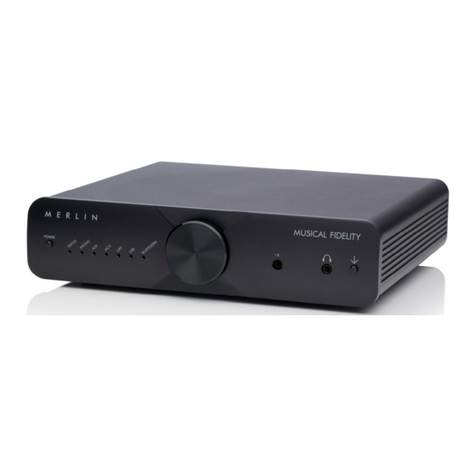
Musical Fidelity
Musical Fidelity MERLIN manual

Musical Fidelity
Musical Fidelity A1 Integrated Instructions for use
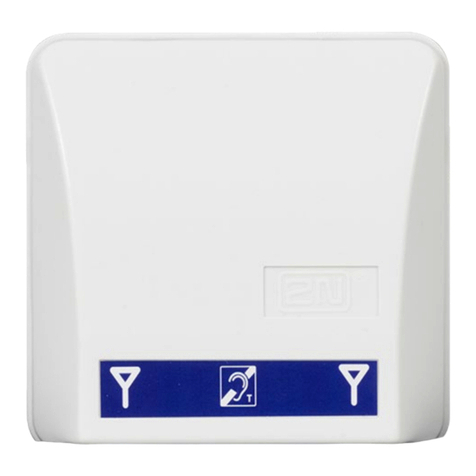
2N
2N Lift Induction Loop Amplifier Instructions for use
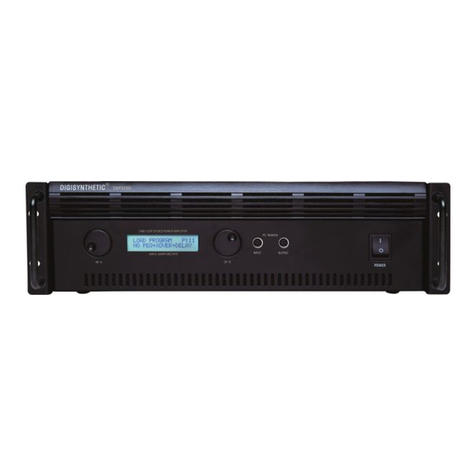
DIGISYNTHETIC
DIGISYNTHETIC DSP4800 user manual
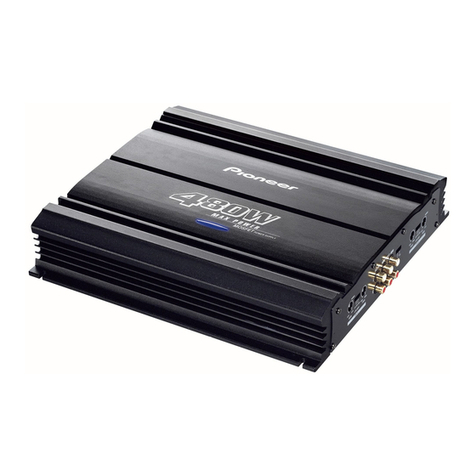
Pioneer
Pioneer GM-6000F owner's manual
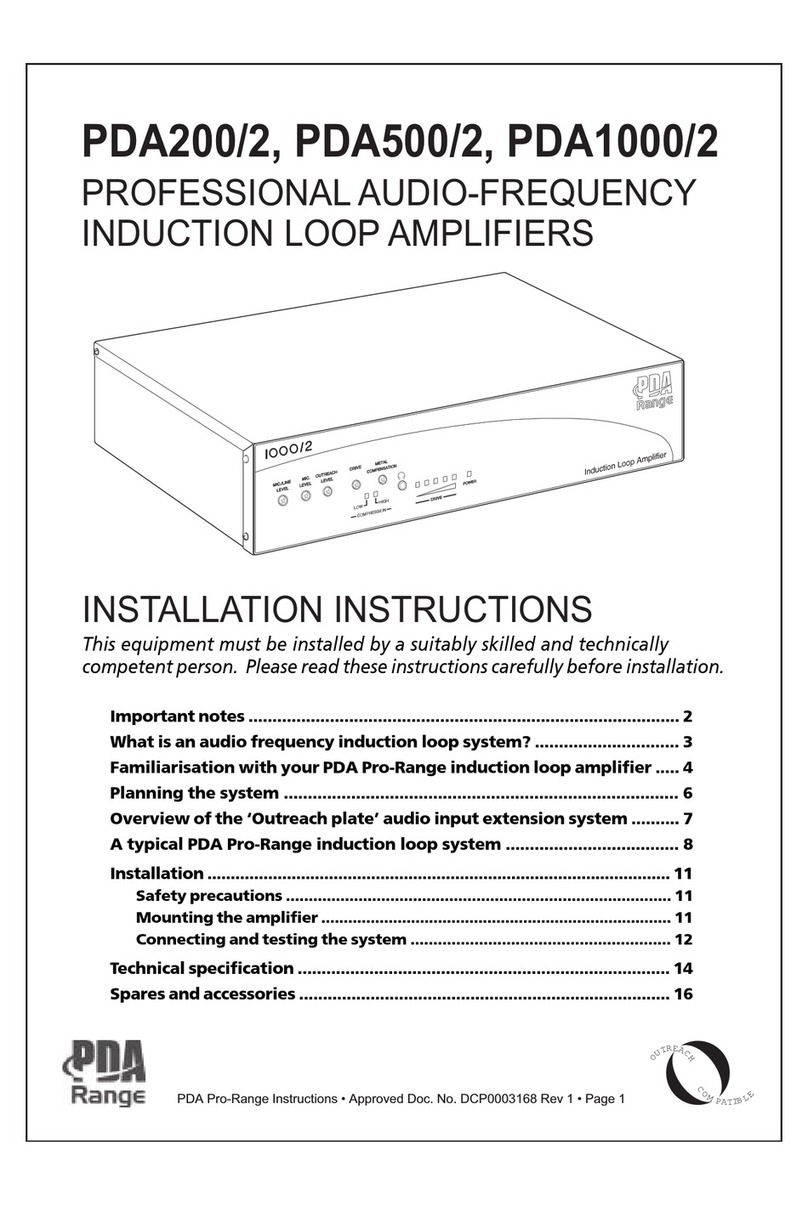
PDA Range
PDA Range PDA200/2 installation instructions
